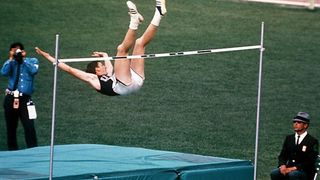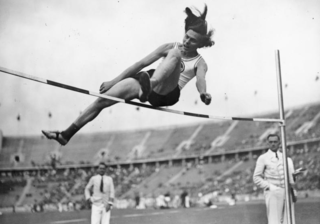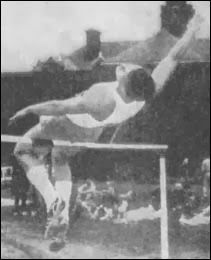Sport and Competition
Dick Fosbury’s Famous Flop Was Actually a Great Success
Created by trial and error, the world of sport was changed forever 50 years ago.
Posted October 19, 2018
"Consider … the Fosbury Flop, an upside-down and backward leap over a high bar, an outright—an outrageous!—perversion of acceptable methods of jumping over obstacles. An absolute departure in form and technique. It was an insult to suggest, after all these aeons, that there had been a better way to get over a barrier all along. And if there were, it ought to have come from a coach, a professor of kinesiology, a biomechanic, not an Oregon teenager of middling jumping ability. In an act of spontaneity, or maybe rebellion, he created a style unto itself." (Hoffer, 2009)
Perhaps the clearest and most compelling case of a behavioral innovation arising without planning and foresight is the now-famous Fosbury Flop. 50 years ago, along with millions of other television viewers on October 20, 1968, I watched in utter amazement as Oregon State University’s 21-year-old Dick Fosbury revolutionized the sport of high jumping with a gold-medal and Olympic-record bound of 7 feet, 4 1/4 inches at the Mexico City games (captured on video). Fosbury accomplished this fabulous feat by sailing over the crossbar head first and backward! As colorfully described that day by the Los Angeles Times’s legendary sportswriter Jim Murray, “Fosbury goes over the bar like a guy being pushed out of a 30-story window.”
How did this most unorthodox maneuver originate? Origin stories are notoriously difficult to corroborate. The people responsible are usually deceased and written records of the events involved are scant or lacking. But, Dick Fosbury has been quite available and willing to tell his tale, as he has on many different occasions (some excellent stories and quotations are to be found in pieces authored by Burnton, 2012; Cummings, 1998; Hoffer, 2009; and Turnbull, 1998; as well as in the transcript of a November 28, 2014 Spikes interview, in the transcript of a February 1998 ESPN SportsZone online chat, and in numerous online videos).

At first, Fosbury joked with sportswriters: informing some that, because of his advanced university background in physics and engineering, he had initially designed the Flop on paper, and telling others that he had accidentally stumbled upon this technique when he once tripped and fell backward on his takeoff (Hoffer, 2009).
However, in later interviews, Fosbury provided a more candid and accurate account of the Flop’s development, revealing that it actually unfolded over many years and involved countless trials and errors. “It was not based on science or analysis or thought or design. None of those things. Just intuition. It was simply a natural technique that evolved. The interesting thing was that the technique developed in competition and was a reaction to my trying to get over the bar. I never thought about how to change it, and I’m sure my coach was going crazy because it kept evolving. I adapted an antiquated style and modernized it to something that was efficient. I didn’t know anyone else in the world would be able to use it and I never imagined it would revolutionize the event. I wasn’t trying to create anything, but it evolved that way.”
Fosbury further expanded on the birth of the Flop: “When I first learned to high jump at the age of 10 or 11, I tried jumping with the ‘scissors’ style. I used that style until I went into high school in Medford, Oregon, when my coach, Dean Benson explained that I would never get anywhere with that technique. He started me with the ‘belly roll’ or straddle technique. However, I was really lousy with that style. I expressed my frustration to coach and he said that if I really wanted, I could still use the scissors.


So, I decided on the bus trip to the next meet [the Rotary Invitation in Grants Pass] to go back to the scissors. During the competition, as the bar was raised each time, I began to lift my hips up and my shoulders went back in reaction to that. At the end of the competition, I had improved my best by 6 inches [to 5’10”] and even placed third! The next 2 years in high school [and later in college], with my curved approach, I began to lead with my shoulder and eventually was going over head first like today’s Floppers.”
In this way, the Flop evolved, not from design, but from an entirely trial-and-error process which combined repeated effort with the biomechanics of Fosbury’s gangly 6’4” physique. Sports Illustrated writer Richard Hoffer (2009) incisively described Fosbury’s subsequent efforts to refine his jump in this way: “It was on-site engineering, his body and mind working together, making reflexive adjustments with only one goal, getting over the bar. His arms and legs were still all over the place, but what looked like an airborne seizure was actually Darwinian activity. Those tics and flailings that served to get him even a quarter inch higher survived. The rest were gradually pared away.” The Darwinian analysis of ‘survival of the fittest’ behavior is especially to be noted.
As for his later training and Olympic triumph, Fosbury remarked: “I didn’t train to make the Olympic team until 1968. I simply trained for the moment. I never even imagined I would be an Olympic athlete. It always seemed to evolve.”
What did Fosbury think of the seeming awkwardness of his Flop? After all, when he first competed with the Flop, competitors and spectators alike teased and derided him. “I believe that the flop was a natural style and I was just the first to find it. I can say that because the Canadian jumper, Debbie Brill was a few years younger than I was and also developed the same technique, only a few years after me and without ever having seen me.”

Indeed, Brill did enjoy a successful high jumping career using her own rather similar method—the “Brill Bend". She placed first in four significant international competitions: the 1970 and 1982 Commonwealth Games, the 1971 Pan American Games, and the IAAF World Cup in 1979. Brill also competed in two Olympic Games: placing eighth in 1972 and fifth in 1984.
A striking coincidence? Yes, indeed. But, perhaps not as striking as the fact that Bruce Quande—a student at Flathead High School in Kalispell, Montana—was photographed on May 24, 1963 at Montana’s state high school meet flopping backward over the crossbar! This was the same month that Fosbury recalls having flopped for the first time at the Rotary Invitation track meet in Grants Pass, Oregon.
Giving credit where credit is due, Quande must be deemed the first Flopper, as he had been using the backward technique some 2 years prior to this 1963 meet. Nevertheless, Quande never enjoyed much success during high school or in his later high jumping career at St. Olaf College. Said Fosbury after learning of Quande’s earlier efforts: “I think it’s real interesting. Our stories sound parallel. This will be a historical asterisk.” And, so it is.

An additional factor must be acknowledged in the evolution of the Fosbury Flop—the landing pit. As Hoffer (2009) pointedly observed: “Completing the Flop successfully was only half the battle; the return to earth still had to be negotiated. Few would even consider such an experiment in flight knowing they’d have to land on their necks.”
When Fosbury was jumping as a sophomore in high school, he had to land in pits which were filled with wood chips, sawdust, or sand. On one occasion, Fosbury hit his head on the wooden border of an old sawdust pit. On another occasion, he landed totally out of the pit, flat on his back, knocking the wind out of him. The next year, Fosbury’s high school became the first in Oregon to install foam rubber in its high jump pit, thereby cushioning the jumper’s fall and encouraging the use of the potentially dangerous Flop. The Fosbury Flop and cushioned landing areas thus appear to have co-evolved fortuitously.
Beyond the historic achievement of the technique itself, the alliterative Fosbury Flop moniker has been synonymous with the high jump since Fosbury struck gold in Mexico City 50 years ago. The origin of that nickname is of also of interest.
Here is how Fosbury came to name the Flop. “I’m very proud that I received the naming rights. But the term by which the style is known did not appear overnight. To tell the truth, the first time that I was interviewed and asked ‘What do you call this?’ I used my engineering analytical side and I referred to it as a ‘back lay-out.’ It was not interesting, and the journalist didn’t even write it down. I noted this. The next time that I was interviewed, that’s when I said ‘well, at home in my town in Medford, Oregon, they call it the Fosbury Flop’—and everyone wrote it down. I was the first person to call it that, but it came from a caption on a photo [in my hometown newspaper, the Medford Mail-Tribune] that said, ‘Fosbury flops over bar.’ The context in Oregon was that our town was on a river, very popular for fishing, an hour from the Pacific Ocean. And when you land a fish on the bank, it’s flopping. That’s the action, and so it’s a good description by a journalist, and I remembered [and adapted] it.” Dick Fosbury not only invented the Flop, but he named it too!
Given the common goal of getting over the high bar, Fosbury broke ranks with his competitors and adopted a most uncommon style. All in all, and in the words of Frank Sinatra’s signature song, Fosbury might properly say, “I did it my way!” Yet, he would positively not say, as does the song, “I planned each charted course, each careful step along the byway!” Nothing could have been more contrary to the origins of Fosbury’s signature style.




